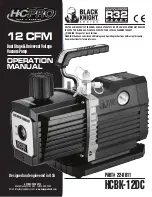
48
CAUTION
Before manually operating the valve, make sure that a drain line has been attached to the valve to
direct the discharge to an open drain. Failure to take this precaution could mean contact with
extremely hot water passing out the valve during this checking operation.
FLUSHING PROCEDURE FOR MINERAL SCALE REMOVAL FROM HEAT EXCHANGER
The amount of calcium carbonate (minerals) released from water is in direct proportion to water
temperature and usage. The higher the water temperature or water usage and the harder the water
(more dissolved calcium carbonate), the more mineral deposits are dropped out of the water. This is the
mineral scale that forms in pipes, water heaters, and on cooking utensils.
Mineral accumulation reduces the efficiency and longevity of the heat exchanger coil and will cause the
water heater to malfunction. The mineral scale may need to be periodically removed from the heat
exchanger (indicated by the “LC” code on the remote display). The usage of water softening equipment
greatly reduces the hardness of the water. However, this equipment does not always remove all of the
hardness (minerals). The heat exchanger may occasionally need to be flushed to clear out the mineral
deposits. Use the following procedure and Figure 20 to flush the heat exchanger and remove the mineral
scale.
1. Disconnect power to the water heater.
2. Close the shut-off valves in the cold water inlet and outlet supply (V3 and V4).
3. Connect pump outlet hose (H1) to the cold water line at valve (V2). Connect drain hose (H3) to
valve (V1).
4. Pour 4 gallons of virgin, food grade, white vinegar or citric acid into a 5 gallon bucket.
5. Place the drain hose (H3) and the hose (H2) to the pump inlet into the cleaning solution.
6. Open the both valves (V1 and V2) to the hot and cold water lines.
7. Turn on power to the circulating pump and allow the vinegar to circulate through the heat
exchanger coil for at least 45 minutes. Heat exchangers containing a considerable amount of
minerals may require several hours.
8. Turn off power to the circulating pump.
9. Remove the free end of the drain hose (H3) from the pail and route it to a drain.
10. Close the valve (V2) and open shut-off valve (V4). Do not open shut-off valve (V3).
11. Allow water to flow out of the hose for 5 minutes to flush vinegar from the water heater.
12. Close service valve (V1) and open shut-off valve (V3).
13. Disconnect the hoses from the valve connections.
14. With (V4) closed, remove the in-line filter at the cold water inlet and clean out any residue. Place
the filter back into unit and open (V4).
15. Restore power to the water heater and check operation.
Содержание EverHot TG-150E-N
Страница 20: ...20 Figure 6 Recommended Piping for a Basic Installation...
Страница 21: ...21 Figure 7 Recommended Piping for a Circulation Systems...
Страница 25: ...25 Figure 9 Recommended Piping for Combination Water and Space Heating Applications...
Страница 31: ...31 Figure 11 Wiring Diagram for TG 150E N X TG 180E N X and TG 199E N X Models...
Страница 32: ...32 Figure 12 Wiring Diagram for TG 237E N X and TG 237E N X A Models...
Страница 51: ...51 SECTION IX PARTS LIST TG 150E TG 180E and TG 199E Models...
Страница 53: ...53...
Страница 55: ...55...
Страница 57: ...57...
Страница 59: ...59 TG 237E Models...
Страница 61: ...61...
Страница 63: ...63...
Страница 65: ...65...
Страница 70: ...70 NOTES...
Страница 71: ...71 NOTES...
















































